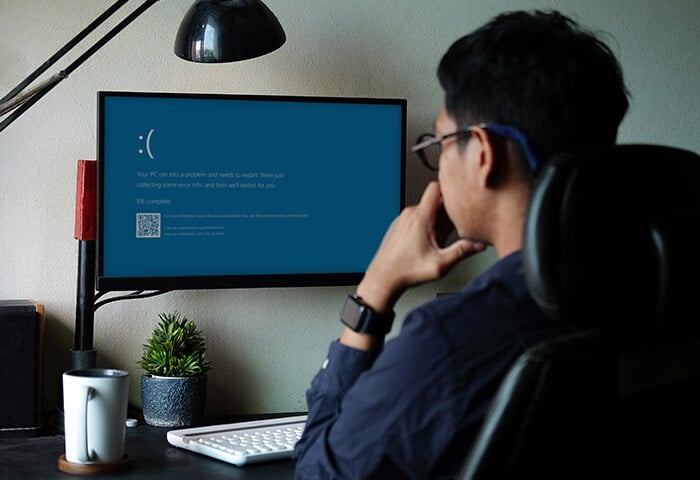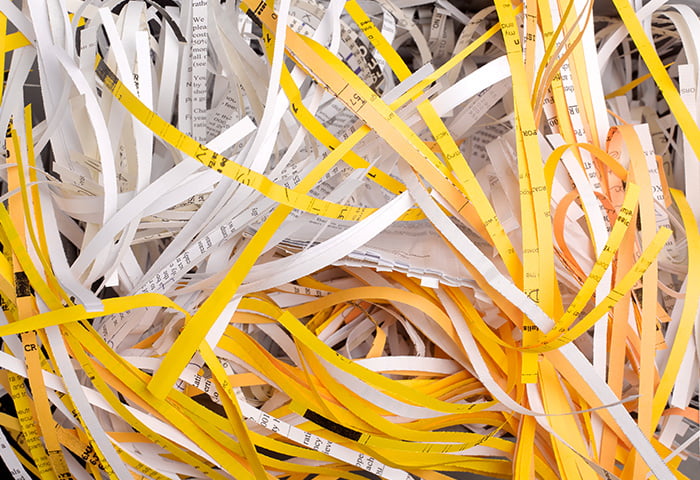11 steps to fix the blue screen of death
Getting the Windows blue screen of death can be frustrating and concerning. But whether you’re using Windows 10 or 11 and getting a blue screen on startup or during normal usage, the problem usually isn’t as alarming as it first seems. Often, it can be resolved by rolling back software installations or updating to the latest version of Windows.
The best way to fix the BSoD is to isolate and resolve the issue by following the steps below:
1. Prepare your PC for Safe Mode
Safe Mode is a Windows startup option that loads only essential system files and drivers, allowing you to troubleshoot and repair issues with minimal interference.
Before entering Safe Mode, turn your computer off and unplug all peripherals (except the mouse and keyboard) as USB devices could be the cause of the blue screen of death.
Then, switch your PC back on again—if your computer boots normally, enter Safe Mode by following these steps:
-
Press the Windows key, type msconfig, and hit enter.

-
Select the Boot tab.

-
Under Boot options, check Safe boot and choose the Minimal setting, then OK. Restart your computer to enter safe mode.

If the BSoD reappears, making it impossible for you to proceed, you’ll need to power down again and follow the steps in our comprehensive guide on restarting Windows 10 or 11 in Safe Mode.
2. Uninstall recently installed programs
Once you’re in Safe Mode, you can begin removing programs that might be causing the BSoD. If the blue screen of death only started appearing after you recently installed something new on your computer, then the fix might be as simple as uninstalling it.
Here’s how you can uninstall programs and apps on Windows 10 or 11:
Windows 11
To uninstall an app on Windows 11:
-
Press the Windows key, type Settings, and hit Enter.
-
Click Apps, followed by Installed apps.
-
Find the software you want to uninstall from the list, click the three dots next to it, and then Uninstall.
Windows 10
To uninstall a Windows 10 program:
-
Press the Windows key, type Add or remove programs, and hit Enter.
-
Select the software you suspect is causing the blue screen of death and click Uninstall.
3. Install the latest Windows update
Updating Windows to the latest version can often resolve Windows update errors and other STOP errors, as updates include bug fixes, security patches, and driver updates that may address the issue.
To ensure you’re running the latest update, press the Windows key > Settings > Update & Security (Windows Update on Windows 11), and then follow the on-screen prompts to check for the latest update.

4. Rollback or disable drivers
Using the latest drivers improves the speed and security of your device. But sometimes bugs or glitches in updates can cause BSoD driver power state failures and other problems. If the blue screen error code referred to a specific driver causing the issue, simply disabling it or rolling back a recent update should fix the problem.
It’s cumbersome to check every computer driver and roll each of them back separately, but you may need to if nothing else works. Here’s how to disable drivers:
-
Press the Windows key, type Device Manager, and hit Enter.

-
Right-click the hardware component and select Properties from the pop-up menu.

-
Click the Driver tab and select Roll Back Driver.

5. Scan your computer for malware
Malware could be responsible for the corrupt files or critical process disruption that has caused your system to crash. In that case, you’ll need to repair and secure your computer with a dedicated malware and virus removal tool that will let you scan and get rid of the malware.
Install AVG AntiVirus Free to identify and remove malicious threats to your system. AVG’s advanced threat-detection technology will quickly wipe away threats and help keep your computer from crashing.
6. Run an SFC scan
System File Checker, or Windows SFC, allows you to check for, and repair, corrupt system files in Windows that could be causing your computer to show the blue screen of death and can be performed in safe mode.
Here’s how to run an SFC scan:
-
Press the Windows key, type Command Prompt, then right-click the top result and select Run as administrator.

-
Type SFC /scannow into the Command Prompt window, press Enter, and restart your computer once the scan is complete.

7. Scan your hard drive
The file system on your hard drive can sometimes become corrupted, causing errors and crashes. Running a CHKDSK scan lets you examine every bit of your hard drive, flag any errors, and correct them or index them to prevent those errors from causing performance issues or crashes such as the dreaded BSoD.
Here’s how to check your hard drive status by running a CHKDSK scan:
-
Press the Windows key, type Command Prompt, then right-click the top result and select Run as administrator.

-
Type chkdsk /f /r into the Command Prompt window and press Enter to find and repair errors with your file system. You may need to restart your computer for the chkdsk scan to start.

8. Check your computer's RAM
If a problem with your RAM is causing blue screen errors or other performance issues, check the status of your RAM using the Windows Memory Diagnostic. Memory hardware is particularly susceptible to degradation over time, and while this diagnostic tool can’t repair it, it can prevent your computer from trying to reference the damaged memory.
Here’s how to use Windows Memory Diagnostic to check the state of your RAM:
-
Press the Windows key, type Windows Memory Diagnostic, then press Enter.

-
Click Restart now and check for problems (recommended).

You’ll see the diagnostic results as soon as you boot up again. You can also go back and review them at any time in Windows Event Viewer. If your memory is seriously corrupted, it’s probably time to upgrade your RAM.
9. Restart your PC to see if the BSoD reappears
It’s now time to exit Safe Mode and restart Windows normally to see if the problem has been fixed. If the BSoD doesn’t reappear, you’ve probably successfully isolated and resolved the problem. Now you can start carefully reinstalling external devices, programs, and drivers that you previously removed.
If the BSoD reappears, you can try the Windows troubleshooting tool.
10. Use the Windows troubleshooting tool
Also known as the fix-it tool, the troubleshooting tool can help you understand what might be causing your computer to keep showing the blue screen. These troubleshooters can help you with issues with network adapters, printers, and program compatibility.
To find the right troubleshooter on Windows 11, select Start > Settings > System > Troubleshoot > Other troubleshooters, and choose the right troubleshooter from the list.
To find the right troubleshooter on Windows 10, select Start > Settings > Update & Security > Troubleshoot > Additional troubleshooters, and choose the right troubleshooter from the list.
11. Last resort: reinstall Windows
If you’ve tried all the steps above and you can’t fix the blue screen, try reinstalling Windows onto a formatted hard drive. This is a big step, but it should fix any blue screen of death, unless your hardware is defective.
Note that unless you have a backup, reinstalling Windows will result in the loss of all your files and user data. If you haven’t backed up recently, there are third-party software tools that will help you copy your drive to an external HDD or SSD.
To reinstall Windows, you’ll need to have your Windows product key—thankfully, Microsoft has made that easier with the latest Windows releases.
What is BSoD?
The blue screen of death is what you see on your computer screen when the Windows operating system crashes because of a fatal system error that causes it to malfunction and shut down, as was the case during the widespread outages caused by the July 2024 Crowdstrike incident.
The BSoD has become infamous and is commonly believed to indicate an unfixable error with a device. But while it’s always frustrating to see the blue screen, the “fatal” system error that caused Windows to crash can usually be fixed.
In Windows 10 and 11, the blue screen comes with a Windows stop code, which refers to the exact error that caused the blue screen. It will tell you what caused the blue screen of death so you can learn how to fix it and stop it from happening again.
Blue vs black screen
Whereas a blue screen of death appears in Windows when a critical system error occurs, the Black Screen of Death is a blank screen that appears when the operating system fails to load completely. As disconcerting as BSoD may be, a totally blank screen is far more troubling.
While it’s often possible to fix a black screen in Windows, it typically indicates a more serious problem.
What causes the blue screen of death?
The blue screen of death often stems from hardware issues such as aging or damaged parts, incompatible software, or malware. Failed driver updates for graphics cards or other components can also trigger BSoDs if they don’t integrate well. Overheating may be a factor, especially if you notice a loud fan or high disk usage in Task Manager.
You’ll see the cause of your BSoD displayed on the error screen itself. The cause will show up either as text, which you can google, or a QR code that you can scan with your phone. If the error code you’re getting isn’t helping you find out what’s causing the problem, generating a memory dump may provide some insight.
Why does my computer keep blue screening
Repeated blue screens often signify that there’s a deeper problem to resolve beyond a simple quick fix. Failing hardware can cause recurring instability, as can unresolved driver conflicts, especially with graphics or network cards. Frequent crashes may also indicate missing system updates or corrupted Windows files.
If you’re stuck in a BSoD loop and you’re met with the same blue screen error each time the computer restarts, try booting into a USB device and reinstalling Windows as a last resort.
Common Windows stop codes
The error code that is given to you when a blue screen of death appears is called a Windows STOP Code. The stop code can help you identify and fix the problem, and stop it from happening again.
Here’s a list of some of the stop codes you’re most likely to find on the blue screen in Windows 10 or 11:
-
SYSTEM_SERVICE_EXCEPTION
Usually these errors are accompanied by the name of the offending driver that caused the blue screen, making fixing these errors easier.
-
DRIVER_POWER_STATE_FAILURE
This can occur when a driver falls into sleep mode suddenly or is unable to wake up properly from sleep mode.
-
DPC_WATCHDOG_VIOLATION
The DPC watchdog constantly monitors for unresponsive programs, and can sometimes become overwhelmed. When that happens, this error appears.
-
VIDEO_TDR_FAILURE
These STOP errors occur when the graphics processor becomes overwhelmed. This can be due to the driver malfunctioning or the hardware itself becoming overloaded.
-
PAGE_FAULT_IN_NONPAGED_AREA
Some parts of your computer's memory are given more importance than others, when your OS is unable to retrieve memory from these areas, a BSoD error occurs.
-
DRIVER_IRQL_NOT_LESS_OR_EQUAL
This STOP code error occurs when the computer needs to access a part of the memory but is unable to interrupt the job the processor is currently doing as it usually would.
Don’t worry—you don’t need to memorize all of those codes. When you see a Windows STOP code error, just look it up online to find out what exactly the problem is and how to troubleshoot the specific issue.
How to prevent Windows blue screen of death
To help prevent Windows' blue screen of death, keep your system updated, including drivers and Windows updates. Regularly check hardware health, especially RAM and hard drives, and scan for malware. Avoid incompatible software and overclocking, and ensure adequate storage space.
Here’s what you can do to keep the Windows blue screen of death away from your display:
-
Keep your Windows installation up to date, as well as any drivers and other software programs so that you benefit from any bug and security fixes.
-
Perform regular malware scans with a trusted antivirus program to avoid an infected computer causing blue screen errors.
-
Regularly check your hardware for damage and keep it clean with air spray and a microfiber cloth.
-
Keep disk space free by uninstalling unused and unwanted software.
-
Make sure you trust the software that you install on your PC. If you’re worried, you can always perform an internet search and see what other people have experienced when using the same software.
But remember, nothing can guarantee you won’t ever get blue screen errors, or other types of crashes, so don’t forget to regularly back up your data to safeguard against unexpected system failures.
Help avoid the BSoD error with AVG
The best way to help prevent blue screen errors and other performance issues is to use an automated optimization tool that works quietly in the background to keep your system running smoothly.
AVG TuneUp will help you free up storage space by removing junk and bloatware, and it will perform regular maintenance tasks to keep your system clean. Plus, AVG TuneUp will let you easily hibernate background processes to ensure your system isn’t overcooked, and it will even help you update your software and drivers automatically. Start your free AVG trial today.




























